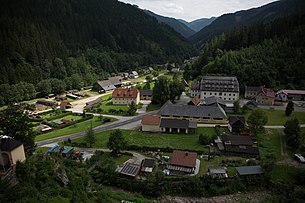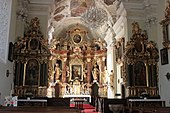Radmer
|
Radmer
|
||
|---|---|---|
| coat of arms | Austria map | |
|
|
||
| Basic data | ||
| Country: | Austria | |
| State : | Styria | |
| Political District : | Leoben | |
| License plate : | LN | |
| Main town : | Radmer at the room | |
| Surface: | 82.44 km² | |
| Coordinates : | 47 ° 33 ' N , 14 ° 45' E | |
| Height : | 729 m above sea level A. | |
| Residents : | 521 (January 1, 2020) | |
| Postal code : | 8795 | |
| Area code : | 03635 | |
| Community code : | 6 11 12 | |
| NUTS region | AT223 | |
| Address of the municipal administration: |
Radmer 3 8795 Radmer |
|
| Website: | ||
| politics | ||
| Mayor : | Ludwig Gottsbacher | |
|
Municipal Council : (2020) (9 members) |
||
| Location of Radmer in the Leoben district | ||

|
||
| Source: Municipal data from Statistics Austria | ||
Radmer is a municipality with 521 inhabitants (as of January 1, 2020) in Styria , in the judicial district or district of Leoben in Austria.
geography
Geographical location
The Radmer is located in the middle of the mountains of Upper Styria, between Eisenerz , Hieflau and Johnsbach .
Expansion of the municipal area
The community extends over the area of the Radmertal , which is surrounded by mountains Lugauer , Kaiserschild and Zeiritzkampel .
Community structure
The municipal area includes the following two localities and cadastral communities of the same name (population in brackets as of January 1, 2020):
- Radmer an der Hasel (149)
- Radmer an der Stube (372)
Neighboring communities
| Rural | ||
| Admont |

|
Iron ore |
| Forest on the Schober Pass | Kalwang |
history
The earliest written document is from 1426 and is "Redmir". The name goes back to the Slavic personal name Radomir or Radimir .
Population development
Data according to Statistics Austria

Culture and sights
Paradeisstollen
The Paradeisstollen is a copper mine. Visitors can travel through the late medieval copper mine with a tunnel train . In its heyday, the Radmer copper mining was one of the four most important copper mining sites in Central Europe and consisted of around 60 tunnels. The highest output was reached in 1596 with 480 tons of raw copper . In 1634 one of the first explosions with black powder in the Alpine countries took place in this mine . In the 16th and 17th centuries, the copper mine was owned by the abbots of the Seitenstetten Abbey in Lower Austria. In the operating building of the show mine there is a show room in which finds from the mine as well as minerals and other exhibits are on display.
Sanctuary of St. Anthony of Padua
The pilgrimage church of St. Anthony of Padua , which was inaugurated on August 10, 1602, is located in the Radmer an der Stube district. The church was designed by the court builder Giovanni Pietro de Pomis , the plans were implemented by the builder Hans Reßl. This church was considered the patronage church of Emperor Franz Joseph.
- The high altar from around 1727 with its column architecture and gallery portals occupies the entire end of the choir. The centerpiece is the altar panel from 1602. It shows Saint Anthony of Padua with the baby Jesus on his arm.
- Two side altars of the same size from 1681 adorn the triumphal arch at the entrance to the high altar. A picture of the Immakulata dominates the St. Mary's altar facing the Gospel. On the epistle side, the large altarpiece shows the “three holy girls” (Saints Barbara, Katharina and Margaretha).
- The pulpit dates from 1714 and is attributed to Josef Claudius Zeller.
- In 1737, a new organ was installed on the originally double gallery by the organ builder Johann Georg Mitterreither from Graz.
- With a view to the tricentenary in 1902, the frescoes in the church were repainted in 1899/1900. The Viennese painters Hermann Ulrich and Carl Otto Czeschka were commissioned to do this . After a fire in 1951, the church had to be renovated again. Another renovation outside took place in 1990 and the interior in 1992–1993. In addition, the community received two new crystal chandeliers from a Munich donor named “Radmer”.
Greifenberg Castle
The former imperial Austrian hunting lodge Greifenberg (originally called Greifenstein ) in the upper Radmertal with four-storey round corner towers dates back to a palace built around 1600. At that time, under the ennobled jurist Johann Baptist Linsmayr von Greiffenberg (1542–1608), grandfather of the baroque poet Catharina Regina von Greiffenberg , it became the seat of a trade and was structurally given its present-day appearance. In the 19th century it belonged to the Seitenstetten Abbey in Lower Austria, and at the end of the century it became a hunting lodge of the Austrian Emperor Franz Joseph . As an inheritance from the heir to the throne, Archduke Franz Ferdinand von Habsburg-Este, it passed to his morganatic descendants, the princes and dukes of Hohenberg, after his murder in Sarajevo in 1914 . Greifenberg Castle was transferred to Heide and Franz Hohenberg through the division of ownership of the Hohenberg forest enterprise. The castle is uninhabited and is in a state of decay.
Manor house in Radmer No. 19
The building was already a hunting lodge “in Redmeregg” during the time of Emperor Maximilian I von Habsburg (1459–1519), was expanded into a castle in 1602 and was later an administrative building for the mining industry. Today the portal, the walled-up double windows, mighty vaults and door jambs testify to the age and importance of the building.
Hunting lodge in Radmer
In the years 1872/1873 the one-storey former imperial Austrian hunting lodge was built east of the Sankt Antoniuskirche in the district Radmer an der Stube in the appearance of a mountain house in Switzerland according to the plans of the court architect Anton Ölzelt . Emperor Franz Joseph I stayed here when he came to the Radmer to hunt at court. After the emperor's death, the 20,000 hectares of forest property were transferred to the orphans of the Archduke heir to the throne Franz Ferdinand of Austria-Este , Max, Sophie and Ernst von Hohenberg , who were murdered in Sarajevo in 1914 . After the annexation of Austria in 1938, Maximilian and Ernst Hohenberg were deported to the Dachau concentration camp because they had spoken out in favor of Austria's independence and against the "Anschluss" with the German Reich . Their possessions, including the forest property in Radmer, were expropriated by the German Reich. It was not returned until 1949. Later the forest property was divided among the heirs. The hunting lodge is now used by the Hohenberg family as a residence and forest management.
Sports
The mountains around the Radmer are often used for hiking and ski tours. Above all, the steep ascent to the Lugauer is known . In the area there are several alpine pastures such as B. the Seekaralm, the Kammerlalm, the Neuburgalm or the Schafbödnalm where the Brunnkaralm at the foot of the Zeiritzkampel is also worth seeing. The hiking area around Radmer is also characterized by the fact that it is mostly fog-free in autumn.
Regular events
The cattle drive takes place every autumn in the Hinterradmer.
In the Vorderradmer every year at Antoni (mid-June) there is a festival on Saturday, the following Sunday is a Kirtag .
Every year at Whitsun there is a Whitsun football tournament.
Established businesses
- Freiherrlich von und zu Guttenberg'sche private foundation
Personalities
Personalities associated with Radmer
- Thomas Cardeza (1875–1952), American entrepreneur and explorer
literature
- Karl A. Redlich: The Radmer an der Hasel copper mine, the continuation of the Styrian Erzberg. In: Mining and metallurgy yearbook of the KK Montanist Universities in Leoben and Přibram. Vol. 53, 1905, ZDB -ID 512297-1 , pp. 1-38.
- Susanne Gröbl: The copper ore mining in the Radmer from the beginning to 1650 (= dissertations of the Karl-Franzens-University Graz. 69). dbv-Verlag for the Technical University, Graz 1986, ISBN 3-7041-9029-2 (also: Graz, University, dissertation, 1986).
- Benedikt Wagner: Sources on Styrian mining in the Benedictine monastery Seitenstetten. In: 2nd Heritage Symposium: The Cultural Heritage in Mining and Geosciences, Libraries - Archives - Museums. Leoben 1995 (= reports of the Federal Geological Institute. Vol. 41, ISSN 1017-8880 ). Federal Geological Institute, Vienna 1997, pp. 257–260, ( digital version (PDF; 271.22 kB) ).
Web links
- 61112 - Radmer. Community data, Statistics Austria .
- www.radmer.at Homepage of the Radmer community
Individual evidence
- ↑ Statistics Austria: Population on January 1st, 2020 by locality (area status on January 1st, 2020) , ( CSV )
- ↑ Fritz Frhr. Lochner von Hüttenbach: On the name property of the early Middle Ages in Styria (= magazine of the Historical Association for Styria . Volume 99 ). Böhlau Verlag, Vienna 2008, p. 48 ( historerverein-stmk.at [PDF; 16.9 MB ]).
- ↑ A look at the municipality of Radmer <61112> (PDF) Statistics Austria. Retrieved September 30, 2019.
- ^ The emperor at the jubilee of the parish church in Radmer. In: Neuigkeits-Welt-Blatt , August 14, 1902, p. 9 sheet (online at ANNO ).
- ↑ see also a detailed article by Karl von Bentele: Die Kirche in der Radmer. : Allgemeine Bauzeitung , year 1905, pp. 35–39 (online at ANNO ). , also plates 11-14 .
- ↑ http://www.radmer.at/index.php/tourismus/sehenswerte/wallfahrtskirche
- ↑ Burgen-Austria.com
- ↑ Hohenberg Forest Estate website









